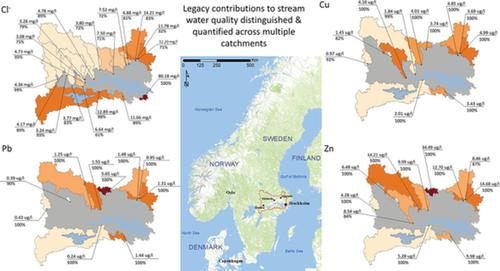当前位置:
X-MOL 学术
›
Hydrol. Process.
›
论文详情
Our official English website, www.x-mol.net, welcomes your
feedback! (Note: you will need to create a separate account there.)
Distinguishing active and legacy source contributions to stream water quality: Comparative quantification for chloride and metals
Hydrological Processes ( IF 2.8 ) Pub Date : 2021-06-23 , DOI: 10.1002/hyp.14280 Georgia Destouni 1 , Jacopo Cantoni 1 , Zahra Kalantari 1, 2
Hydrological Processes ( IF 2.8 ) Pub Date : 2021-06-23 , DOI: 10.1002/hyp.14280 Georgia Destouni 1 , Jacopo Cantoni 1 , Zahra Kalantari 1, 2
Affiliation

|
Hydrochemical constituents in streams may originate from currently active sources at the surface and/or legacy sources from earlier surface inputs, waste deposits and land contamination. Distinction and quantification of these source contributions are needed for improved interpretation of tracer data and effective reduction of waterborne environmental pollutants. This article develops a methodology that recognizes and quantifies some general mechanistic differences in stream concentration and load behavior versus discharge between such source contributions. The methodology is applied to comparative analysis of stream concentration data for chloride (Cl−), copper (Cu), lead (Pb), and zinc (Zn), and corresponding data for water discharge, measured over the period 1990–2018 in multiple hydrological catchments (19 for Cl−, 11 for Cu and Zn, 10 for Pb) around the major Lake Mälaren in Sweden. For Cl−, the average load fraction of active sources is quantified to be 19%, and the average active and legacy concentration contributions as 2.9 and 11 mg/L, respectively. For the metals, the average active load fractions at outlets are 1%–3% over all catchments and 9%–14% in the relatively few catchments with mixed metal sources. Average active and legacy concentration contributions are 0.14 and 3.2 μg/L for Cu, 0.05 and 1.5 μg/L for Pb, and 1.4 and 12 μg/L for Zn, respectively. This multi-catchment analysis thus indicates a widespread prevalence of legacy sources, with greater legacy than active concentration contributions for both Cl− and the metals, and active contributions playing a greater role for chloride than for the metals. The relatively simple first-order methodology developed and applied in the study can be used to screen commonly available stream monitoring data for possible distinction of active and legacy contributions of any hydrochemical constituent in and across various hydrological catchment settings.
中文翻译:

区分活跃和遗留源对河流水质的贡献:氯化物和金属的比较量化
溪流中的水化学成分可能来自地表当前活跃的来源和/或来自早期地表输入、废物沉积和土地污染的遗留来源。需要对这些来源的贡献进行区分和量化,以改进对示踪数据的解释和有效减少水源性环境污染物。本文开发了一种方法,可以识别和量化这些源贡献之间在流浓度和负载行为与排放方面的一些一般机械差异。该方法应用于氯离子 (Cl -)、铜 (Cu)、铅 (Pb) 和锌 (Zn),以及 1990-2018 年期间在多个水文流域(Cl - 19 ,Cu 和 Zn 11,Cu 和 Zn 10)测量的相应排水数据Pb)在瑞典主要的梅拉伦湖周围。对于 Cl -,活性源的平均负载分数被量化为 19%,活性和遗留浓度的平均贡献分别为 2.9 和 11 mg/L。对于金属,出口处的平均活性负荷比例在所有流域中为 1%–3%,在金属混合源相对较少的流域中为 9%–14%。Cu 的平均活性和遗留浓度贡献分别为 0.14 和 3.2 μg/L,Pb 为 0.05 和 1.5 μg/L,Zn 为 1.4 和 12 μg/L。因此,这种多流域分析表明遗留源广泛流行,对 Cl -的遗留源比活性浓度贡献更大和金属,氯化物比金属起更大作用的活性贡献。研究中开发和应用的相对简单的一阶方法可用于筛选常用的河流监测数据,以区分各种水文流域环境中和跨水文环境中任何水化学成分的活跃和遗留贡献。
更新日期:2021-07-13
中文翻译:

区分活跃和遗留源对河流水质的贡献:氯化物和金属的比较量化
溪流中的水化学成分可能来自地表当前活跃的来源和/或来自早期地表输入、废物沉积和土地污染的遗留来源。需要对这些来源的贡献进行区分和量化,以改进对示踪数据的解释和有效减少水源性环境污染物。本文开发了一种方法,可以识别和量化这些源贡献之间在流浓度和负载行为与排放方面的一些一般机械差异。该方法应用于氯离子 (Cl -)、铜 (Cu)、铅 (Pb) 和锌 (Zn),以及 1990-2018 年期间在多个水文流域(Cl - 19 ,Cu 和 Zn 11,Cu 和 Zn 10)测量的相应排水数据Pb)在瑞典主要的梅拉伦湖周围。对于 Cl -,活性源的平均负载分数被量化为 19%,活性和遗留浓度的平均贡献分别为 2.9 和 11 mg/L。对于金属,出口处的平均活性负荷比例在所有流域中为 1%–3%,在金属混合源相对较少的流域中为 9%–14%。Cu 的平均活性和遗留浓度贡献分别为 0.14 和 3.2 μg/L,Pb 为 0.05 和 1.5 μg/L,Zn 为 1.4 和 12 μg/L。因此,这种多流域分析表明遗留源广泛流行,对 Cl -的遗留源比活性浓度贡献更大和金属,氯化物比金属起更大作用的活性贡献。研究中开发和应用的相对简单的一阶方法可用于筛选常用的河流监测数据,以区分各种水文流域环境中和跨水文环境中任何水化学成分的活跃和遗留贡献。











































 京公网安备 11010802027423号
京公网安备 11010802027423号